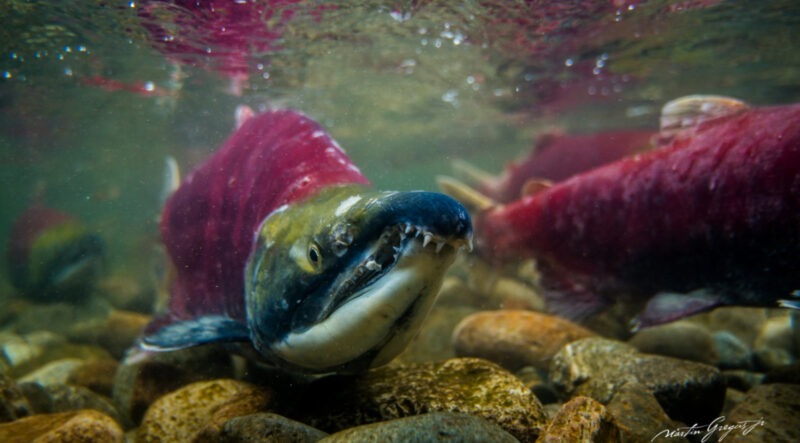Toxic hotspots, road runoff endangering BC salmon runs
Emerging threats will further endanger British Columbia’s wild salmon populations say recent studies and reports.
By Fabian Dawson
SeaWestNews
Aquaculture detractors, especially on Canada’s west coast, tend to blame declining wild fish stocks squarely on the marine operations of salmon farmers.
Despite a wealth of science that states marine aquaculture in British Columbia does not pose more than minimal risk to wild Pacific salmon, the anti-fish farming lobby keeps scapegoating salmon farmers as the cause for declining wild stocks.
But a recent slew of studies and reports state there is a lot more at play like toxic hotspots, runoff from roads, and mining that are endangering British Columbia’s wild salmon.
A study led by Simon Fraser University researchers finds that mining companies are staking claims on future salmon habitats as glaciers retreat.
In the ice-covered transboundary region shared by northern B.C. and Alaska, glacier retreat is creating thousands of kilometers of new rivers that salmon are finding. These emerging rivers represent future habitats for salmon, but mining companies are also looking to these areas for the next gold mine.
A new study published in Science maps out these emerging land use conflicts and identifies policy blind spots as well as key opportunities for the stewardship of these nascent habitats.
The paper discovered that of the 114 subwatersheds in the transboundary region with future salmon habitat, 25 had more than 50% of future salmon habitat near a mining claim. In addition, more than half of future salmon habitat in Canada has either medium or high mineral potential, an indicator of future potential mining pressure.
“Climate change and other human activities are harming salmon populations in much of their range. Yet in some locations of northern B.C. and Alaska, glacier retreat is creating hotspots of opportunity for salmon, but also of mining pressure. This is an emerging environmental issue,” said SFU professor Jonathan Moore, the study’s lead author and head of the Salmon Watersheds Lab.
The paper also illuminates a broad global challenge – as climate change is rapidly transforming the world, environmental policies may struggle to keep pace. For example, risk assessments and habitat protections by current environmental laws generally focus on the current values of ecosystems, but not their future values.
“Climate change is transforming ecosystems around the world,” said Moore. “Even as there is urgent need to take global action on climate change, this paper also reveals the need to look carefully at environmental laws and make sure that they not only protect habitats of today, but also the habitats of tomorrow.”
Meanwhile, Canada’s National Observer via the Local Journalism Initiative reported that newly identified toxic metal hot spots on the West Coast further threaten endangered killer whales and salmon, their key food source.
The majority of coastal chinook stocks in the whales’ core range are also struggling as a result of habitat destruction, overfishing and climate change, said Joseph Kim, Research Scientist with Ocean Wise, who did the study.
The research is part of the long-standing Ocean Wise Pollution Tracker program, the first coast-wide contaminant-monitoring program in Canada.
Victoria Harbour and Prince Rupert Harbour are the top toxic hot spots, with an overlap of problematic metals as well as other worrisome chemical contaminants, which are likely tied to industrial and urban activity in these highly populated areas, the tracker shows.
Lead levels in sediment were especially high in Prince Rupert and Victoria harbours compared to the rest of the coast, the recent study showed.
Victoria Harbour’s mercury levels are also high enough to likely harm small seabed creatures at the base of the food chain for salmon and, ultimately, whales.
Less-populated sites like Haida Gwaii, Vancouver Island’s coast, Georgia Strait and B.C.’s north and central coasts are also hot spots for mercury, cadmium, arsenic, nickel, copper and lead, the study noted.
Another issue that has re-emerged is the use of toxic chemicals in the production of tires.
West Coast fishing groups have federal a lawsuit against 13 of the largest tire manufacturers in the U.S., alleging the companies are illegally killing or harming endangered salmon and oceangoing trout by the use of toxic chemicals in their products.
The lawsuit filed in U.S. District Court in San Francisco alleges that the tire-makers violated the U.S. Endangered Species Act through the discharge of 6PPD-quinone, a chemical derived from a preservative that helps tires last longer, said the Seattle Times.
The chemical has been linked to mortality in coho salmon returning to Puget Sound streams and, the groups allege, is harming Chinook and steelhead.
The Pacific Coast Federation of Fishermen’s Associations and the Institute for Fisheries Resources’ complaint outlines two dozen endangered populations of salmonids along the West Coast that have been impacted by the chemical.
In 2020, researchers revealed that the toxic chemical was the culprit behind the deaths of coho in about 40% of the Puget Sound area. The study found it kills 40% to 90% of coho returning to some urban streams before they spawn.
Fisheries and Oceans Canada (DFO) said it is monitoring 6PPD-quinone concentrations in over 40 creeks around Metro Vancouver, Squamish and Vancouver Island for the last two-and-a-half years and has found the presence of 6PPD-quinone consistently exceeding lethal concentration levels, especially during rainfall.
(Salmon in a BC river – Photo by Canada One 50)

